ve always been fascinated by the natural world, and one of my favorite subjects is bird-watching. Amidst the vast array of avian species, one that’s particularly striking is the Black-Hooded Oriole. A creature of vivid hues and melodic songs, it never fails to captivate.
Native to parts of Asia, this oriole boasts a distinctive coat that’s hard to miss. Its golden body contrasts sharply against its black hood and wings – a visual spectacle in the verdant landscapes it calls home.
From its perch high in the trees, it trills a melody that can echo across forests, drawing attention from miles around.
But there’s more to this bird than just its appearance or song. It has unique behaviors and lifestyle traits, making it an intriguing subject for study. So let me take you on a journey into the world of this splendid creature – our focus today: the Black-Hooded Oriole.
Overview of the Black-Hooded Oriole
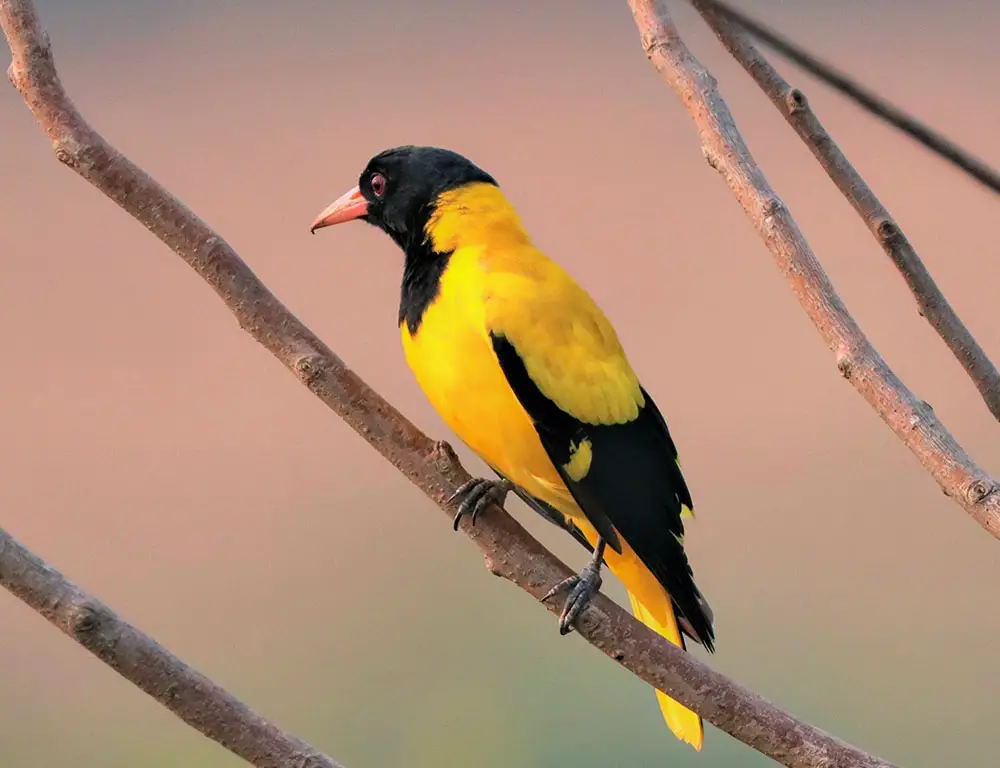
The Black-Hooded Oriole, with its striking appearance and melodious song, is a captivating bird native to parts of Asia. Here’s an overview of this beautiful species:
Appearance
Sporting a distinct black-and-yellow palette, the Black-Hooded Oriole features a warm golden-yellow body and wings contrasted by an intense black head and throat, resembling a hood. Males typically exhibit brighter colors compared to females.
Habitat
This oriole species thrives in diverse habitats ranging from thick forests to well-wooded urban areas, showcasing its adaptability to different environments.
Diet
Primarily insectivorous, the Black-Hooded Oriole feeds on insects and enjoys fruits occasionally.
Facts
- Scientific Name: Oriolus xanthornus
- Average Length: 23-25 cm
- Weight: Around 60 grams
- Lifespan: Up to 15 years in the wild
Song
Known for its enchanting song, the Black-Hooded Oriole produces a series of whistles and chatters that resonate beautifully through its natural habitats.
Nesting Habits
These birds construct intricate cup-shaped nests hanging from tree branches, laying two to four eggs at a time.
Both parents participate in nest-building and chick-feeding duties during the breeding season, typically from March to August, depending on the region.
Physical Characteristics of the Black-Hooded Oriole
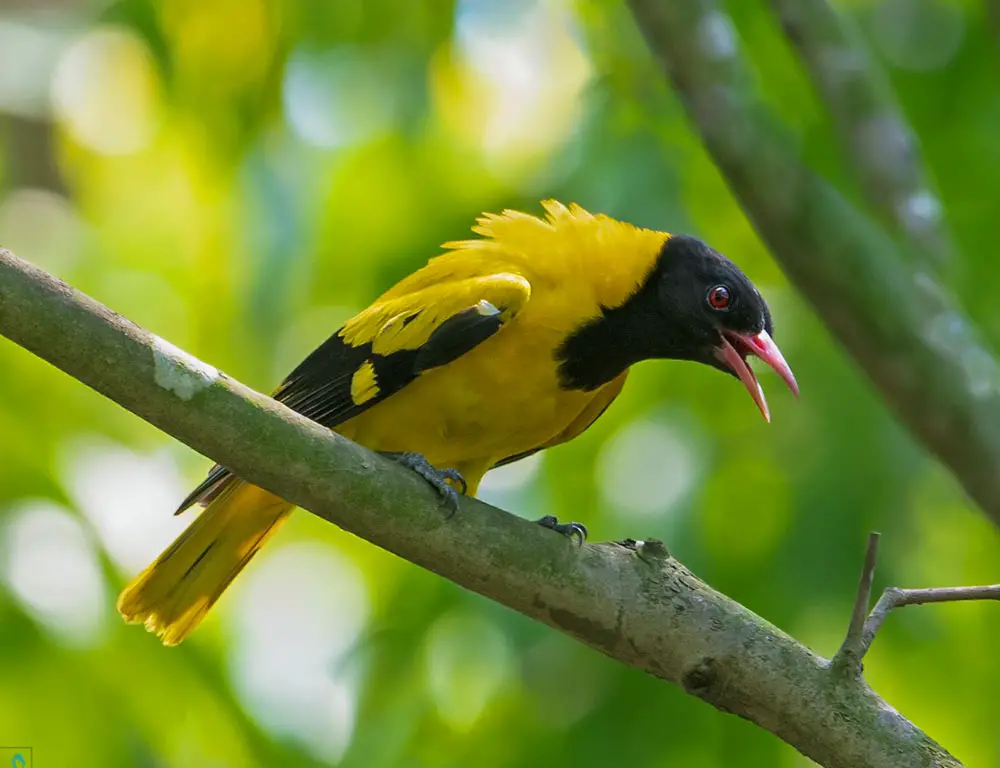
The Black-Hooded Oriole boasts a stunning appearance that captivates observers with its striking coloration and graceful physique.
Here’s a summary of its physical attributes:
Coloration
Its vivid yellow body is its most striking feature, contrasting sharply with the black “hood” that envelops its head, neck, and upper breast. This color combination resembles a masked appearance, hence its name.
Size
Measuring 20-23 centimeters, the Black-Hooded Oriole is more significant than many other oriole species. Its size, coupled with its slender build, aids in its agile flight maneuvers, whether foraging for food or evading predators.
Beak
Equipped with a strong, slightly curved downward beak, the Black-Hooded Oriole is adept at breaking open fruits and insects, which form the bulk of its diet.
Wings
With relatively long wings compared to their body size, these Orioles are agile flyers, capable of quick movements and swift flights through the canopy.
Sexual Dimorphism
One of the unique aspects of this species is its sexual dimorphism. Males boast radiant golden-yellow bodies with a solid black hood, while females exhibit slightly paler yellow bodies without a distinct hood pattern.
Habitat and Distribution of the Black-Hooded Oriole
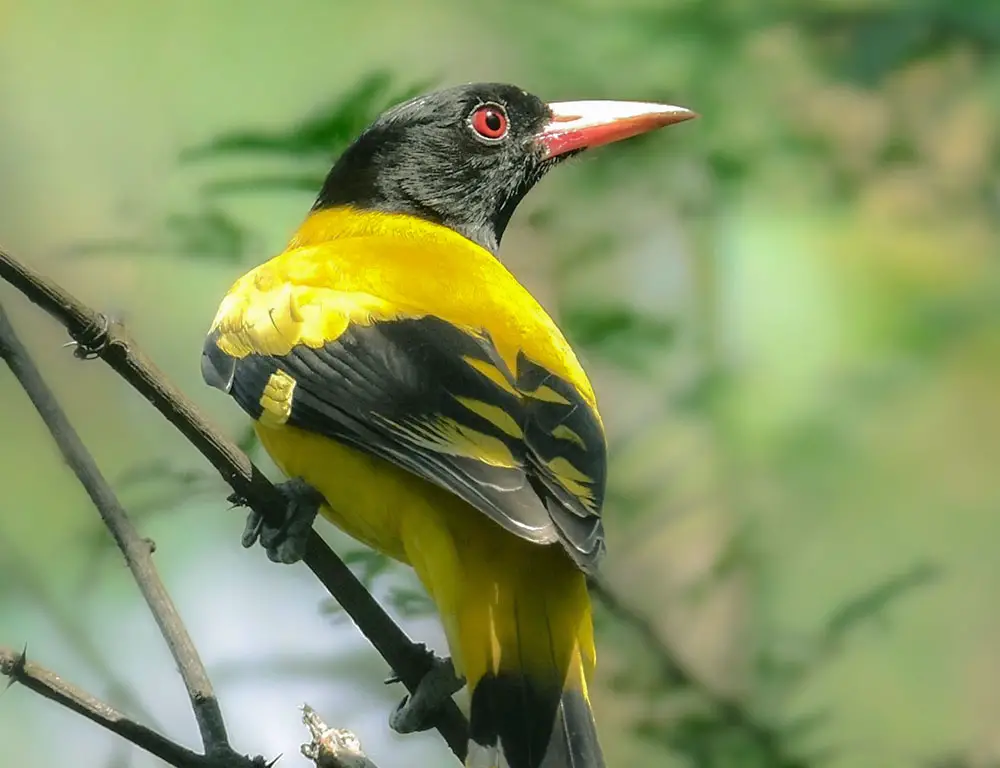
The Black-Hooded Oriole exhibits a diverse habitat range and a widespread distribution across South Asia and parts of Southeast Asia.
Here’s a detailed exploration of its habitat preferences and geographical distribution:
Habitat Preferences
These vibrant birds are adaptable to various habitats but prefer tropical and subtropical regions. They are commonly found in open woodland areas, gardens, plantations, and forest edges.
Additionally, they have shown a remarkable ability to thrive in urban environments, often nesting near human settlements.
Geographical Distribution
- India: Black-Hooded Orioles are widespread across India, from the plains to the Himalayan foothills, reaching altitudes of up to 1500 meters.
- Sri Lanka: They are found throughout the island of Sri Lanka.
- Indonesia: In Indonesia, they are primarily found on the islands of Sumatra and Java.
- China: Black-Hooded Orioles inhabit the southern provinces of China.
Urban Adaptation
These adaptable birds have demonstrated a lack of shyness towards human settlements, often seen nesting in urban areas. This adaptability to human-altered environments further expands their habitat range.
Seasonal Movement
Unlike some bird species, Black-Hooded Orioles do not undertake significant migrations. They are considered resident breeders throughout most of their range, indicating a stable presence in their preferred habitats year-round.
Diet and Feeding Behavior of the Black-Hooded Oriole
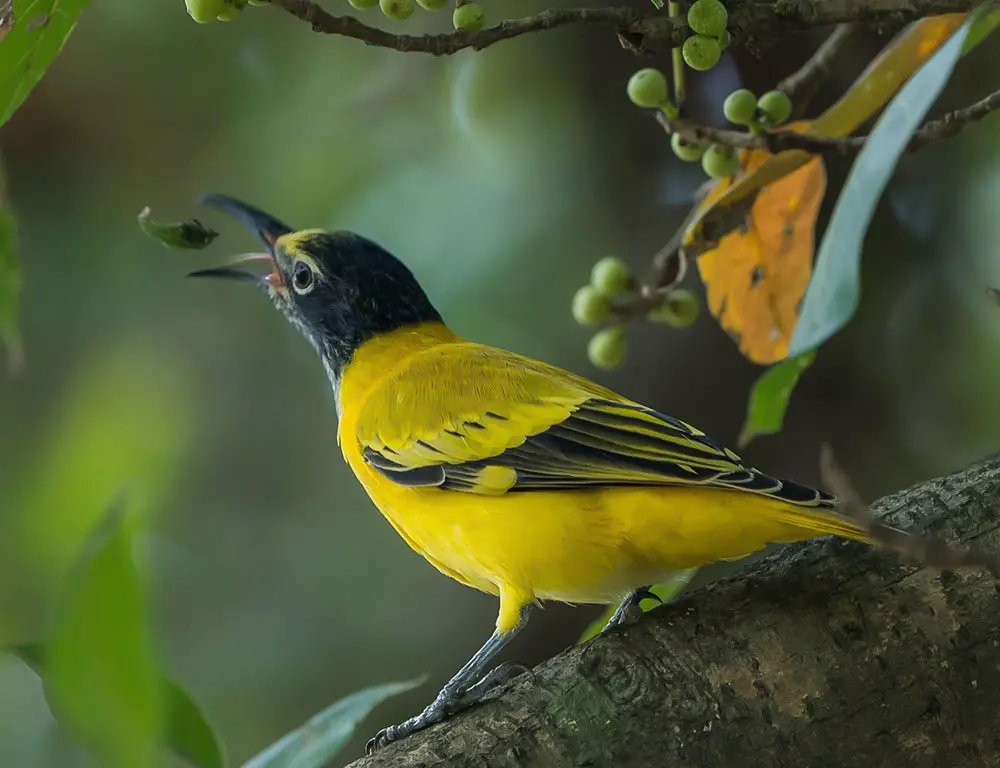
The Black-Hooded Oriole possesses a diverse and fascinating diet, showcasing its omnivorous nature and adept feeding behaviors.
Here’s an in-depth look at its dietary preferences and feeding habits:
Omnivorous Diet
Black-Hooded Orioles are opportunistic feeders, consuming various food sources. Their diet primarily consists of:
- Insects: They prey on various insects such as beetles, ants, and caterpillars. Their agile flight allows them to catch insects mid-air, showcasing remarkable hunting skills.
- Nectar: These orioles supplement their diet with nectar obtained from flowers. Their long, curved beaks are perfectly adapted for reaching deep into blossoms to extract nectar.
- Fruits and Berries: Ripe fruits and berries, including figs, are also a significant part of their diet. They display persistence and dexterity in plucking fruits from trees to satisfy their hunger.
Feeding Techniques
Black-Hooded Orioles exhibit impressive feeding techniques tailored to their diverse diet:
- Mid-air Hunting: They are skilled at catching insects mid-flight, demonstrating agility and precision in aerial pursuits.
- Nectar Extraction: Their specialized beaks extract nectar from flowers efficiently, contributing to pollination as they feed.
- Prey Handling: When consuming more oversized prey items like fruits or beetles, they hold their prey with one foot while tearing it apart with their beak, showcasing remarkable agility and coordination.
Field Observations
Researchers and bird enthusiasts have noted these feeding behaviors firsthand, particularly in regions where Black-Hooded Orioles are commonly sighted, such as the Sundarbans region straddling Bangladesh and India.
Conservation Status of the Black-Hooded Oriole
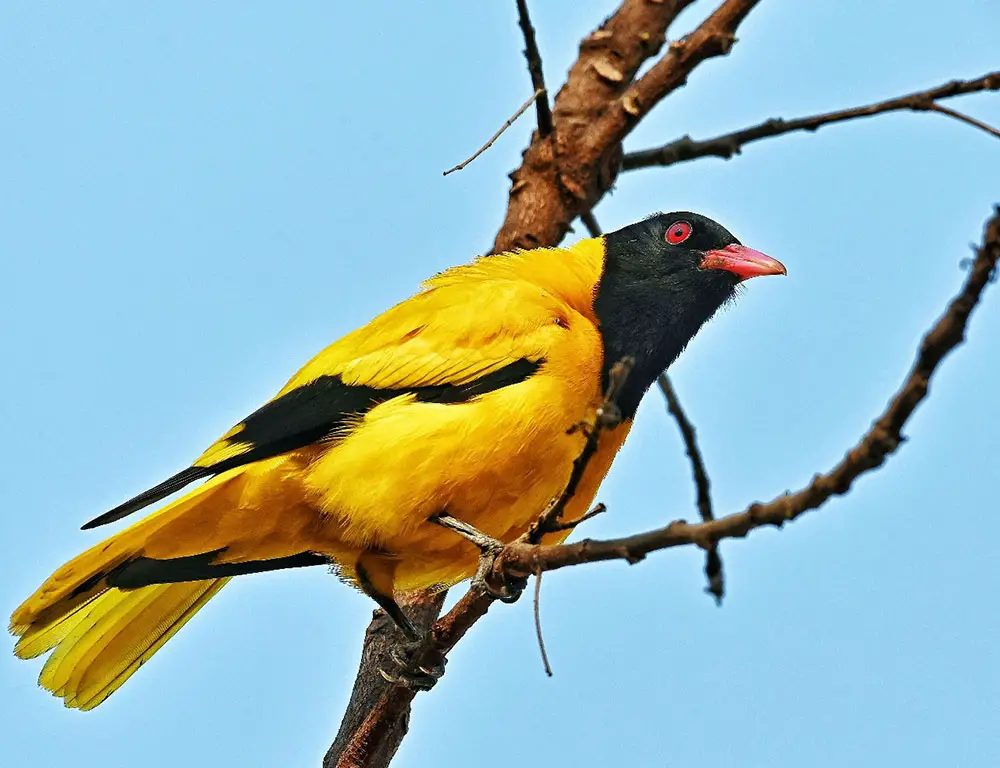
The conservation status of the Black-Hooded Oriole, listed as “Least Concern” by the International Union for Conservation of Nature (IUCN), provides a reassuring outlook for the species’ survival.
However, it’s crucial to delve deeper into the factors contributing to this classification and the ongoing conservation efforts needed to maintain its population.
Here’s a comprehensive overview:
Geographical Range
The Black-Hooded Oriole benefits from a wide geographical distribution spanning multiple countries, including India, Sri Lanka, and Southeast Asia. This broad range reduces its vulnerability to localized threats, such as habitat destruction in specific areas.
Population Trends
While precise population numbers are challenging, observational data suggests stable population trends across its range. Here’s a summary of population estimates:
- India: Stable population trends
- Sri Lanka: Stable population trends
- Southeast Asia: Stable population trends
Threats and Concerns
Despite its “Least Concern” status, the Black-Hooded Oriole is not immune to threats that could potentially impact its population. Key concerns include:
- Habitat Loss: Deforestation and habitat destruction could diminish these birds’ available nesting sites and foraging grounds.
- Pesticide Use: The use of pesticides in agriculture poses a risk of contaminating the Black-Hooded Oriole’s food sources, potentially negatively impacting their health and reproductive success.
- Climate Change: Shifts in climate patterns may alter the availability of suitable habitats for the species, affecting their distribution and breeding success.
Conservation Efforts
Continued vigilance and proactive conservation measures are essential to safeguard the Black-Hooded Oriole and other wildlife species. Conservation efforts may include:
- Habitat preservation and restoration initiatives to maintain suitable breeding and foraging habitats.
- We are monitoring population trends and conducting research better to understand the species’ ecology and conservation needs.
- Collaboration with local communities and stakeholders to promote sustainable land management practices and reduce threats to the species’ survival.
Conclusion
I’ve enjoyed delving into the fascinating world of the Black-Hooded Oriole. It’s a bird that never ceases to amaze me with its vibrant colors and captivating behaviors.
Reflecting on our journey, we’ve learned about its unique traits, distribution, habitat, diet, and reproduction. This species is truly a gem in the avian world. Its striking black and yellow plumage brightens up forests across Asia and has captured my heart.
Let’s take a quick recap:
- The Black-Hooded Oriole is predominantly found in tropical regions of Asia.
- They prefer evergreen forests but can adapt to various environments, including urban parks and gardens.
- Their diet mainly consists of insects, but they also enjoy fruits.
- In breeding season, females usually lay 2 – 3 eggs incubated for around two weeks.
We must strive to protect this splendid creature from threats like deforestation and climate change. Every effort counts when it comes to preserving biodiversity.
In wrapping up this exploration, I’m left with an even greater appreciation for the Black-Hooded Oriole. It serves as a reminder of nature’s stunning beauty and intricate diversity. And so my fascination continues – there’s always more to learn in the enchanting world of birds!